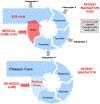Novel academic center model for Spanish-speaking patients in the southeastern United States
- PMID: 32879906
- PMCID: PMC7461717
Novel academic center model for Spanish-speaking patients in the southeastern United States
Abstract
Latinos form the largest U.S. minority and will account for one quarter of the population by 2050. Immigration trends from 1995-2010 challenged health systems in "new destination" regions such as the southeastern U.S., with Latino population increases of 200-400%, and a minimal bilingual health workforce. Academic medical centers and safety net hospitals are challenged to respond beyond the interpreter paradigm of care delivery to provide efficient, cost-effective and compassionate care that complies with the U.S. Title VI mandates. We describe the design and successful implementation of an academic model in the care of Spanish-speaking patients in the pediatric and adult primary care and subspecialty settings in the University of North Carolina Health Care System. This model leverages a limited bilingual workforce to maximize the extent and quality of language-concordant care for this population The innovative features of the UNC Center for Latino Health (CELAH) is based upon five principles: patient navigation, a medical home, a block-scheduling system, a "virtual clinic" model using existing space, and leveraged cost-neutral resources. Patients are scheduled to specific half-day sessions in specialty clinics and matched with bilingual faculty and staff. This facilitates door-to-door care in Spanish for patients, the majority of whom are immigrants from rural Mexico and Central America with limited English and health literacy. CELAH is considered an academic transition model in anticipation of an adequate bilingual health workforce in 1-2 decades. As a hub, this clinical platform supports unique programs in medical education, translational and health equity research, community outreach, and faculty engagement.
Figures


References
-
- Passel JS, Cohn D, Lopez MH (2013) Census 2010: 50 Million Latinos Hispanics account for more than half of the nation’s growth in the past decade. Pew Hispanic Center. Available from: www.pewhispanic.org
-
- Colby SL, Ortman JM (2015) Projections of the size and composition of the U.S. Population: 2014 to 2060. Population Estimates and Projections. U.S. Census Bureau, Current Population Reports 2015; P25–1143. Available from: https://www.census.gov/library/publications/2015/demo/p25-1143.html
-
- Lopez MH, Gonzalez-Barrera A, Cuddington D (2013) Diverse Origins: The Nation’s 14 largest Hispanic-Origin groups. Pew Hispanic Center. Available from: www.pewhispanic.org
-
- Kochhar R, Suro R, Tafoya S (2005) The New Latino South: The Context and Consequences of Rapid Population Growth. Pew Hispanic Center. Available from: https://www.pewhispanic.org/2005/07/26/the-new-latino-south/
-
- U. S. Census Bureau. U.S. Census Bureau QuickFacts: North Carolina. 2018. Available from: https://www.census.gov/quickfacts/fact/table/nc,US/PST045218.
Grants and funding
LinkOut - more resources
Full Text Sources
Research Materials
